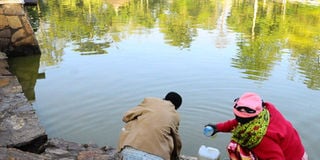Namugongo’s waters of life

Pilgrims draw water from the man-made lake at Namugongo yesterday. They believe it to be holy. PHOTO BY ISAAC KASAMANI
One of the attractions at Namugongo Martyrs Shrine is a manmade lake surrounding the altar from where mass is celebrated to commemorate the proclamation to sainthood of the first group of Ugandans to be enrolled on the list of Catholic saints.
The Anglican Church also has its shrine a few kilometres from which several martyrs were killed. The hundreds of pilgrims, who flock to Namugongo to celebrate Uganda Martyrs Day drink, wash or carry home the water drawn from the lake with a belief that the “holy” water has powers to cure them from incurable ailments, while others believe the water gives them some kind of protection from evil.
However, Fr Joseph Mukasa Muwonge, a Catholic priest familiar with the history of the lake at the Uganda martyrs shrine, says the water is not holy. He says the process is long to claim so, but, he adds, some devotees have reported cures which they can neither refute nor support. Therefore, he advises users to be cautious.
He also says the lake is man-made but has come to signify the beauty and wonders of Namugongo in the mind of both pilgrims and tourists who come to the shrine.
Fr Muwonge, a priest at Namugongo Catholic shrine, is also cautious to call “holy” the water at Namugongo. He says despite some reports they have received of “miraculous interventions”, it is up to the archbishop of Kampala, in consultation with other bishops around the country, and after careful examination by Vatican, that such a pronouncement can be made. He says such a proclamation is yet to be made.
Fr Muwonge philosophically says the water in Namugongo comes to life because it flows constantly. He adds “God can use anything to do his wonders”. However, he advises whoever takes water from Namugongo to first boil it, before they use it because it is apparently “dirty”.
Fr Muwonge says the reports of “miracles” resulting from taking the water from the lake are still being compiled for the archbishop of Kampala to examine and probably take action.
A little history
There was never a lake at Namugongo but a little stream going through a swamp from where Msgr. Lawrence Mbwenga used to grow yams, cabbages and sugarcane.
Actually at the site of the shrine, only one martyr was killed there. His name was Charles Lwanga. But now, a relic of Charles Lwanga is being kept under the altar on the island in the middle of the magnificent lake, from where a mammoth crowd pays its devotion.
Msgr. Mbwenga, who passed away three years ago and native of Buvuma Island, however, got this idea of opening up a place with a larger water basin which could remind him of the scenery back home. He started piling up mud at one place as he expanded the pond from which he grew fish.
Fr Mbwenga conceived the idea of placing an altar on the mud in 1950s from which pilgrims would see the priest as he conducted mass.
The devotion to Uganda Martyrs grew in leaps and bounds as they were proclaimed saints by Pope Paul VI.
Fr Mbwenga’s idea intrigued the then archbishop of Kampala, Emmanuel Nsubuga, who was going to host Pope Paul VI in 1969.
According to Fr Muwonge, the archbishop saw the small island with a pile of mud from which Fr Mbwenga says mass for pilgrims as the perfect spot for the Pope to say his last mass in Uganda and also commemorate the Uganda Martyrs. He brought the graders to expand the water basin and compiled the mud in one place which was elevated to become the altar it is today.
And when the late pope John Paul II came to Uganda in 1993, Cardinal Emmanuel Wamala asked the then chancellor of Kampala Archdiocese, Fr Kizito Lwanga, to expand and beautify the lake further, giving it a stone fence and more shelters from where pilgrims today sit or stand to say mass. Dr Kizito Lwanga is now the archbishop of Kampala.
The water in Namugongo though is an attraction to many the devotees. The relic (a bone) of Charles Lwanga, one of the martyrs is placed under the altar on the island, and for devotees, the eternal light before the bone is a source of inspiration that whatever surrounds is a holy too.




